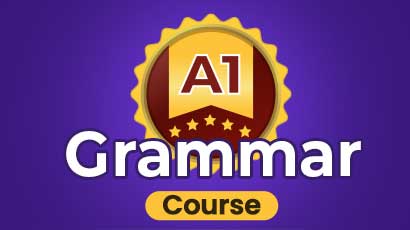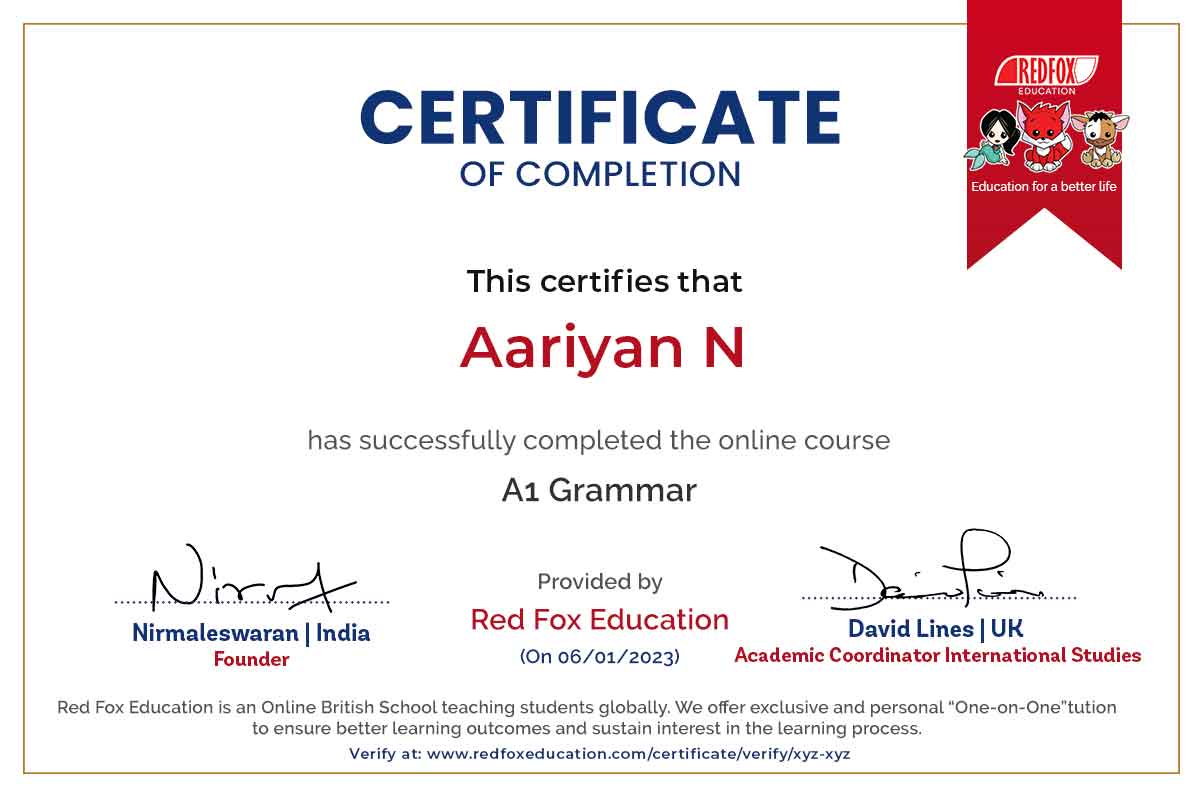
Study Materials:
- Lesson Videos
- Lesson Documents
- Tests
- Worksheets
For ages: 8 and above
A1 Grammar Course
Level 3
After purchasing, the course will be available on the website and mobile app. Red Fox Education mobile app is available free to download on Google Play and App Store.
Course Details
Course overview: Comprehensive step-by-step guide to English grammar for beginners covering all components suggested to reach the A1 standard or level as set out in the CEFR guidelines. [CEFR = Common European Framework of reference for Languages: Learning Teaching Assessment]
Aims & objectives: To understand the grammar elements necessary to:
- use familiar everyday expressions and basic phrases
- introduce yourself and others
- ask and answer questions about personal details such as where you live, what you do, who you know and things you have
- interact with others in simple conversation
Suitable for: Students of all ages who want to improve their English grammar and work towards an internationally recognised standard of proficiency.
Especially useful for beginners to English or those who are returning to study after a period of absence and want to relearn basic English grammar.
Also suitable for school pupils to supplement English classes [from Y5+ / grade 4 +/ age 8+]; or university students wanting to improve or maintain English skills
Possible benefits:
For your career: The course follows the syllabus guidelines for the CEFR A1 level - an internationally recognised language standard; therefore completing the course and obtaining your certificate can prove language proficiency to this level which can be useful when applying for jobs at international companies
Generally: Improve the use of grammar and aid in conversational English
Premium: This is a signature premium course so you need to subscribe to our premium membership
Certificate: A certificate is awarded upon successful completion of the course
Lessons Plan
-
Lesson 1
Uses Of Present Simple -
Lesson 2
Present Simple Of Be -
Lesson 3
Forms Of Present Simple: Positive -
Lesson 4
Spelling Rules For Present Simple -
Lesson 5
Forms Of Present Simple: Negative -
Lesson 6
Questions In Present Simple -
Lesson 7
Short Answer Forms -
Assessment - Chapter 1
Assessment
-
Lesson 1
Uses Of Present Continuous -
Lesson 2
Forms Of Present Continuous -
Lesson 3
Spelling Rules For Present Continuous -
Lesson 4
Using Question Words -
Lesson 5
Stative Verbs -
Lesson 6
Present Continuous Or Present Simple -
Assessment - Chapter 2
Assessment
-
Lesson 1
Use Of Past Simple -
Lesson 2
Forms Of Past Simple -
Lesson 3
Negative Forms Of Past Simple -
Lesson 4
Questions In Past Simple -
Lesson 5
Past Simple Form With Regular Verbs -
Lesson 6
Past Simple Spelling Changes -
Lesson 7
Past Simple Form With Irregular Verbs -
Lesson 8
Past Simple Form With Be -
Assessment - Chapter 3
Assessment
-
Lesson 1
Talking About The Future -
Lesson 2
Forms Of Future Simple: Will -
Lesson 3
Uses Of Future Simple With Will -
Lesson 4
Forms Of Future Simple: Be Going To -
Lesson 5
Uses Of Future Simple: Be Going To -
Lesson 6
Using Question Words -
Lesson 7
Time Markers For The Future -
Lesson 8
Will Or Be Going To -
Assessment - Chapter 4
Assessment
-
Lesson 1
Gerunds -
Lesson 2
Spelling rules for gerunds -
Lesson 3
Infinitives -
Lesson 4
Gerund or Infinitive? -
Lesson 5
Imperatives -
Assessment - Chapter 5
Assessment
-
Lesson 1
Types of nouns -
Lesson 2
Countable nouns: singular & plural -
Lesson 3
Spelling rules for plural nouns -
Lesson 4
Uncountable nouns -
Lesson 5
Measuring words for uncountable nouns -
Lesson 6
Articles for nouns -
Assessment - Chapter 6
Assessment
-
Lesson 1
Number and amount -
Lesson 2
A few or few & a little or little -
Lesson 3
Many & Much -
Lesson 4
A lot of & lots of -
Lesson 5
Some and any -
Lesson 6
This / that / these / those -
Assessment - Chapter 7
Assessment
-
Introduction to Chapter 8
Introduction to Chapter 8 -
Lesson 1
Subject pronouns -
Lesson 2
Object pronouns -
Lesson 3
Possessive determiners -
Lesson 4
Possessive pronouns -
Lesson 5
Some difficult points -
Lesson 6
There is / there are -
Assessment - Chapter 8
Assessment
-
Introduction to Chapter 9
Introduction to Chapter 9 -
Lesson 1
Prepositions of time: at, in & on -
Lesson 2
Prepositions of time: until, from & to -
Lesson 3
Prepositions of time: before & after -
Lesson 4
Prepositions of place: at, in & on -
Lesson 5
Prepositions of place: above & over -
Lesson 6
Prepositions of place: under & below -
Lesson 7
Prepositions after verbs -
Lesson 8
Prepositions after adjectives -
Assessment - Chapter 9
Assessment
-
Introduction to Chapter 10
Introduction to Chapter 10 -
Lesson 1
Use of conjunctions -
Lesson 2
The coordinating conjunctions -
Lesson 3
Rules and guidelines -
Lesson 4
Joining independent clauses -
Lesson 5
Punctuating coordinating conjunctions -
Assessment - Chapter 10
Assessment
-
Introduction to Chapter 11
Introduction to Chapter 11 -
Lesson 1
Modal verbs -
Lesson 2
Can & could as modals of ability -
Lesson 3
Asking for and giving permission -
Lesson 4
Offers and requests -
Assessment - Chapter 11
Assessment
-
Introduction to Chapter 12
Introduction to Chapter 12 -
Lesson 1
What are adjectives? -
Lesson 2
Positioning of adjectives -
Lesson 3
Forming adjectives -
Lesson 4
Adjective or adverb -
Assessment - Chapter 12
Assessment
-
Introduction to Chapter 13
Introduction to Chapter 13 -
Lesson 1
What are adverbs? -
Lesson 2
Adverbs of manner -
Lesson 3
Adverbs of frequency -
Lesson 4
Adverbs of degree -
Assessment - Chapter 13
Assessment
-
Chapter 14 – Review & Final assessment
Chapter 14 – Review & Final assessment -
Chapters 1 – 4
Chapters 1 – 4 -
Chapters 5 – 8
Chapters 5 – 8 -
Chapters 9 – 11
Chapters 9 – 11 -
Chapters 12 & 13
Chapters 12 & 13 -
Assessment - Chapter 14
Assessment


